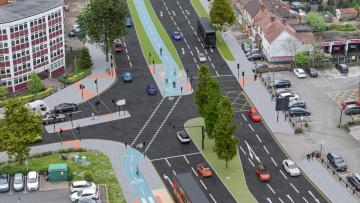
Birmingham City Council has drawn up plans for an extension of the A38 cycle route from Selly Oak to Longbridge, and is consulting on those plans during July 2025. These plans include a segregated bi-directional cycle track which goes down the central reservation, with changes to several junctions along the route to help the people on the cycle track. The consultation finishes on July 28th, and can be found here: https://www.birminghambeheard.org.uk/bcc/a38-cycle-route/
Better Streets for Birmingham have also written a response to this consultation that goes into a lot of detail about the plans. As well as submitting our own response to this consultation, we have said that we support the points that BSfB makes.
Please make sure that you submit a response to the consultation. You can say that you support our response and BSfB's response, as well as giving your own comments about the plans.
At the end of this article we have provided a PDF file with our response to the consultation that we have submitted to Birmingham City Council. This website article goes into slightly less detail than our response, so you might like to also look at our response.
Our overall judgement of the plans:
The plans provide a good level of comfort for cycle users with a high-quality bi-directional cycle route almost continuously from Selly Oak to Longbridge. New traffic lights will be introduced at several junctions, controlling motor traffic crossing the cycle track, to improve safety for all road users, and the plans include new controlled crossings for pedestrians which will make the walking environment safer. However there are far too many gaps in the central reservation, with uncontrolled crossings for cars to go over the bi-directional cycle track. These are more dangerous than traffic light controlled junctions, and should be used sparingly. Another issue is that cycle users will be expected to cycle on the shared-use pavements to get through Northfield town centre, which will reduce continuity and comfort for cycle users using the cycle track to cover longer distances. It is possible that this solution will increase conflicts between people walking and cycling in the town centre.
Overall, we strongly support the aims of the plans and the delivery of a bi-directional segregated cycle track, but we want the gaps in the central reservations to be closed up and a better solution for Northfield town centre.
New crossroads at Middle Park Road and Bournville Lane
Where Middle Park Road and Bournville Lane meet Bristol Road, the central reservation currently blocks anyone from driving straight over from one to the other. To cross over to the other side, drivers have to go a short way in the wrong direction on Bristol Road, and then use a U-turn gap. Pedestrians trying to get over the road here have a foot-bridge to climb up and down, rather than a direct crossing on the road. The emphasis is on moving motor traffic along the A38 as fast as possible. These plans, however, restore the crossroad at this point, with new pedestrian crossings and cycle lane connections from the bi-directional cycle track onto both Bournville Lane and Middle Park Road. The design is a modification of the CYCLOPS junctions being used in Manchester now, to fit in with Birmingham's choice to use bi-directional cycle tracks on the main routes.
The design looks good, with pedestrians having their own space to wait for the traffic lights, while the uni-directional cycle tracks connecting with Middle Park Road and Bournville Lane slip behind them, reducing potential conflicts. But the timings for the traffic lights will be complex, with cycle users on the main cycle track having stop lines for when the uni-directional cycle tracks have a green light. There is also the question of how a cycle user on the shared-use pavement on the 'wrong' side of the road will be able to correctly access the bi-directional cycle track, instead of cycling the wrong way on the uni-directional cycle track. It will be interesting to see how this design works in real-life use, and hopefully lessons can be learnt that will help to inform future junction designs.
Why are the gaps in the central reservation a problem?
There are 22 gaps in the central reservation where motor traffic will have an uncontrolled crossing of the cycle track. Many of these gaps already exist, and the plans propose tightening up the gaps and adjusting the angle so that the cars will approach the cycle track at an angle closer to 90 degrees. Some of the gaps will be moved as well, to give space for cycles between them. The total length of the route is 6 km, although that includes Northfield town centre where there won't be any new cycle track. So this new cycle track will average over 4 uncontrolled motor traffic crossing points for every kilometre. One of the main benefits of having the bi-directional cycle track in the central reservation area is to reduce conflicts at the side roads that join the main road, but the numerous gaps provided for turning cars introduces just as many conflicts as the cycle track would have if it was one side or the other of the main road.
The original stretch of cycle track on the A38, from the city centre to Selly Oak, has an uncontrolled crossings to access Pavenham Drive and for vehicles going into and out of Eastern Road. Pavenham Drive is a dead-end road, and the uncontrolled crossing is only used by the local residents. Eastern Road is a rat-run, used by a large number of motor vehicles, with traffic backing up during rush hours. CrashMap shows 5 crashes associated with the Eastern Road junction from 1999 to 2023, while there are no crashes associated with the Pavenham Drive junction. The Pavenham Drive gap was thought to be necessary because people driving cars on the north side of Bristol Road would have had a substantial diversion along some very heavily congested sections of main road to reach Pavenham Drive. The Eastern Road junction was not given a light controlled junction because of the high number of light controlled junctions on that stretch of Bristol Road, with 4 light controlled junctions in the 1 mile between the junction at the entry to Selly Oak high street and the junction of Bristol Road and Priory Road. We think that a better solution would have been to block off the rat-runs that feed into the Eastern Road junction, to drastically reduce the volume of motor traffic coming through that junction.
The existing gaps in the central reservation between Selly Oak and Longbridge already have a history of collisions. At the Weoley Park Road junction, there were 6 collisions from 2019 to 2023, with 4 of those appearing connected to motor traffic turning right out of Weoley Park Road. At both the Cob Lane and Hole Lane junctions, there were 4 collisions from 2019 to 2023, and at the junction of Hawkesley Mill Lane, there were 9 collisions, with 1 fatality. The junction of Witherford Way also had 4 collisions and 1 fatality.
Why are some U-turn gaps needed?
Unfortunately, with a central reservation and no roundabouts along this section of Bristol Road, there are limited opportunities for cars to turn right across the main road. While traffic-light controlled junctions, such as the new junction of Middle Park Road and Bournville Lane with Bristol Road, allow drivers to turn right, there are dead-end roads and destinations that are only accessible from the main road, such as New Farm House Drive and the Royal Orthopaedic Hospital. People living on Witherford Way, for example, will be able to use Middle Park Road to turn across Bristol Road, but someone from New House Farm Drive will face a longer diversion if they try to use other roads to turn around.
Ideally, U-turn gaps would be provided which would enable access to dead-end side roads and destinations while making rat-runs like Hole Lane and Hill Top Road much less attractive. We suggest that this length of Bristol Road could be divided up into several 'gyratory' systems, each about 800 meters in length, with simple U-turn facilities that are designed to avoid the rat-run roads. We have drawn up a diagram outlining such a 'gyratory' system, between Cob Lane and Hole Lane - see the end of this article for the diagram. Our proposals separate the U-turn facilities from junctions, so that drivers take separate actions for the U-turn and for entering and exiting side roads. This simplification of car movements should improve safety, as drivers have fewer things to focus on at one time. Our proposal would also reduce the number of U-turn facilities from 22 to perhaps 8, significantly reducing the number of conflict points. 800 meters is long enough to make driving less direct than cycling, but not so much that it could be seen as unreasonable, and the extra distance may discourage some people from abusing rat-runs.
We also think that the U-turn gaps need to have deceleration lanes to accommodate motor traffic that is waiting to turn around. When the queue of waiting cars backs onto the general traffic lanes, other drivers weave from one lane to the other, avoiding the queuing traffic while trying to also overtake other cars. This creates dangerous driving conditions for people on Bristol Road and can contribute to collisions. If it is believed that the volume of turning motor traffic will be too high for the deceleration lane, then traffic volume reduction measures, or the introduction of traffic lights, should be considered. If side roads with significant volumes of rat-running motor traffic are considered too important to attempt to reduce the rat-running traffic, then a traffic-light controlled junction should be introduced to make the junction safe, as is proposed at the junction with South Road and Bristol Road.
Mixing signal controlled and give-way lines in a single junction at Weoley Park Road
The plans propose a signallised junction allowing just buses to turn right into Weoley Park Road for buses heading south on Bristol Road from Selly Oak. While the design for this turning looks safe, as cycle riders will have a red light when buses are given a green light, they also allow any motor traffic exiting Weoley Park Road to cross over the bi-directional cycle track and the right-turn bus lane to head south, with only a give-way line to control that crossing action. The traffic lights for the buses will create a gap in the traffic on Bristol Road that will enable car drivers to slip across into the gap in the central reservation, but people on the cycle track might be more focused on the traffic lights than on the uncontrolled crossing for motor traffic before that.
This seems a needless risk to introduce into the cycle track when there is a u-turn facility just up the road that does not cross over the cycle track, and which has a substantial feeder lane to hold motor traffic that wants to turn around. Anyone driving on Weoley Park Road could also reach Middle Park Road, and use the new signallised junction there to travel south on the A38. In keeping with our comments about separating turning movements, we think that motor traffic should not be allowed to turn right out of Weoley Park Road here. This junction is more complicated than the other turning facilities, and we think could be a collision hot spot with the current plans.
Are the passing points on the steep section useful?
After Northfield, the A38 descends a steep hill on its approach to Longbridge. The plans include some passing points, which look to be just a few meters long. We assume that the logic is that if someone is riding slowly up the hill, then having a passing point would provide space for a faster rider to get past them and keep their momentum up the hill. However, for the passing place to be useful, either the slower rider would have to move over into the passing place as they rode up, or the faster rider would need to pass the slower on their left side, within the short distance of the passing point. But how would the slower rider know that someone needed to overtake them at that exact point, or how could the faster rider be sure they would overtake before the passing point ran out and they had to move over again? The passing points on the downhill side of the cycle track are even more confusing, since even slower riders would be going too fast for the short passing point to be of any use.
Concerns have been expressed about there not being enough space to comfortably overtake slower cycle users here, and at the slope between Weoley Park Road and Lodge Hill Road. We think that it would be better to provide 3.5 or 4 meters width along the whole length of these two sections, rather than short passing points.
A38 extension example gyratory system



